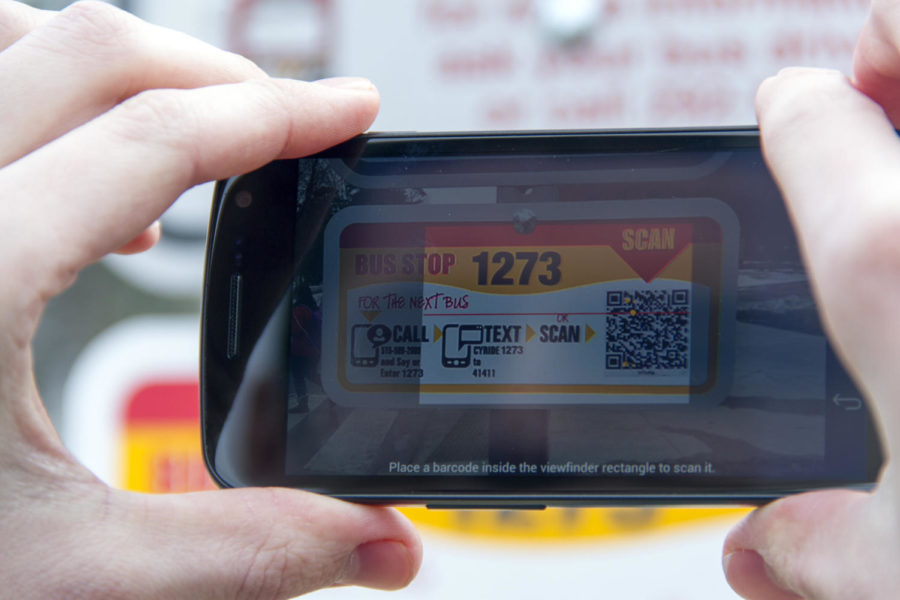Technology fund application streamlined to encourage more student participation
Photo: Megan Wolff/Iowa State Daily
CyRide recently released a new service called NextBus. NextBus tracks CyRide buses using GPS and allows riders to text, call or scan a QR code to track the next bus coming to that stop.
February 10, 2015
The Computational Advisory Committee is implementing a new online system for students to apply for grant funding.
Since the early 1990s, the committee has had an annual application process for funding student, staff and faculty proposals for technology projects.
Projects are funded with a portion of the money all students pay in technology fees. In the past, the portion of the technology fees the committee oversaw was estimated to be near $400,000 a year, and that number is expected to rise as enrollment at Iowa State swells.
The new site was created to allow better student access, a lower barrier to entry and enable more regular reviews of project proposals.
“In the old annual system, if you had a great idea in April, tough toots. You had to wait,” said Jim Twetten, a 10-year member of the committee and the creative force behind the new system.
Twetten also noted that under the old, more intensive application process, many students were discouraged from applying by the requirements of drafting budgets, mission statements and other formal planning documents that had to be approved by the dean of their college before students were able to present their ideas to the Computational Advisory Committee.
“We rarely found students involved in the process, which we decided was not a good thing,” Twetten said. “In this [new] process, students can submit their ideas in as little as a paragraph, instead of having to submit a fully researched, budgeted plan for the idea’s implementation.”
Adam Abbott, a student member of the Computational Advisory Committee, said he liked the new system of applications, as well as the regular monthly voting schedule for approving grants.
“For the last few months of meetings we’ve been primarily working on getting [Techstarter] live,” Abbott said. “We’re glad to have that going now, but the excitement is still to come when we start discussing and deciding on big ideas.”
Abbott said the committee will start discussing the funding of large-scale projects again at its next meeting later this month.
The new system, Techstarter, is accessible to the general public, where new ideas can be proposed, commented on or supported by anyone logged in with a Net-ID at any time.
The site itself is loosely based on the layout of Kickstarter and includes features similar to those of social media sites, including the opportunity to comment on or “like” different posted ideas. Ideas that are newly posted or have garnered more “likes” show up in a list on the front page of the website, with the full list of current proposals available in the menu.
“Part of [a project] is promoting your ideas to others and getting support for it,” Twetten said. “But it’s really important for anyone that’s putting an idea in to be articulate, and to fully describe the idea they want to happen.”
The Computational Advisory Committee reviews the ideas posted on a monthly basis, selecting some projects for further development with the help of the proposer, the committee, and ISU staff. Approved projects will then receive funding for small-scale pilot implementations, whose success determines whether the committee chooses to fund the project on a larger scale.
Past projects include expanding the wireless infrastructure on campus, installing monitors displaying the next bus arrival times at locations such as the Kildee/Bessey transfer point and installing cameras to record lectures in large lecture halls.
An in-progress project is the expansion of the eMuseum searchable online database, which will provide information to the public about what artwork is on display at Iowa State and make this information available for use in classes.
Dr. Thomas Jurik, who proposed the installation of “next bus” monitors at every CyRide stop, said the new application process is very simple to navigate.
“I just posted a paragraph about what I wanted to see happen and that was it,” Jurik said. “It really is that easy.”
For the best chance of success, students and faculty can submit documents and links to outside sources of information supporting their ideas to the Techstarter website along with their proposals.
Twetten also noted that when using the new system, the ideas contributed do not have to be completely set in stone before their submission.
“In previous process, incomplete ideas could only be considered for funding on a yes or no basis, and thus fewer projects were funded because they wouldn’t have been good investments as they were written,” Twetten said. “Now we can help guide ideas in the formative stage … that’s part of what’s exciting to me. We can have discussion and diffuse the ideas on campus better than we ever could before.”
The advisory committee’s next meeting is Feb. 19, when they hope to see some new ideas in the Techstarter database for the committee to evaluate and support.
“The main thing here is we want more student participation,” Twetten said. “We want to emphasize that students can put in any ideas for projects they want to see at Iowa State.”







